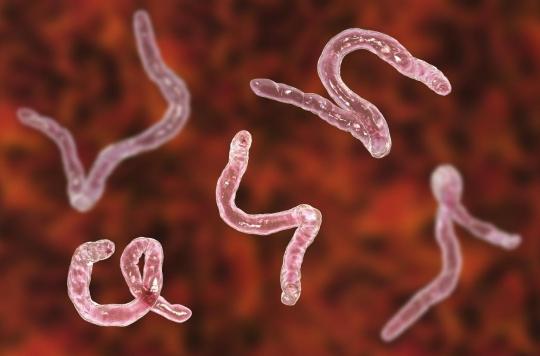An Australian woman who suffered from earth ache has had tapeworm larvae removed from her brain. In France, an epidemic of fish tapeworm was reported in 2019 in Rennes.

- In Australia, a woman suffering from severe headaches was found to have a cyst filled with tapeworm eggs in her brain.
- In 2019 at the Rennes University Hospital, seven patients with fish tapeworm were diagnosed
In Australia, a woman suffering from severe headaches was found to have a cyst filled with tapeworm eggs in her brain. The case study was published in the American Journal of Tropical Medicine and Hygiene.
An 8mm lesion in the brain
A CT scan revealed that the 25-year-old woman, from Melbourne, a coastal city in southeastern Australia, had an 8mm lesion in her brain. Upon removing the lesion, surgeons “unexpectedly” discovered that it was not made of human tissue, but of tapeworm larvae.
Since the age of 18, the patient suffered from migraines that disturbed her vision, two or three times a month, and which generally improved after taking medication prescribed by her doctor. But her latest migraine, which had lasted for seven days and was blurring her sight, led her to the emergency room.
Sushi, maki and other sashimi responsible for the Rennes epidemic
In 2019 at the Rennes University Hospital, seven patients with fish tapeworm were diagnosed, a figure “exceptional in such a short period”underlined Florence Robert-Gangneux, professor in the laboratory of parasitology-mycology of the CHU, quoted by 20 minutes.
The investigation carried out by the CHU estimated that sushi, maki and other sashimi would have been responsible for the epidemic. “We realized that all the patients were customers of Japanese restaurants or regular consumers of sushisays Florence Robert-Gangneux. And since none of them had recently traveled to Japan or the North Pacific, they must have been contaminated by imported fish. Since these restaurants do not cook the fish, those that do not freeze them do not kill the potential tapeworms that lodge there.
What are tapeworms?
Better known as “tapeworm”, tapeworms are flatworms that generally parasitize the digestive tract of vertebrates (the case of the Australian mentioned above is exceptional). Taeniasis is the disease determined by the presence of adult tapeworms in the small intestine of humans. When the worm is growing, in the first months after infestation, it can cause digestive and appetite disorders. But when the worm has matured, it is often well tolerated and shows no symptoms. The tapeworm can also trigger human cysticercosis, which can seriously damage various organs such as the eye, heart, spinal cord and brain.
To get rid of the tapeworm, doctors usually prescribe an antiparasitic drug, such as praziquantel or niclosamide. Once dead, the tapeworm is passed out with the stool through natural means.
.















